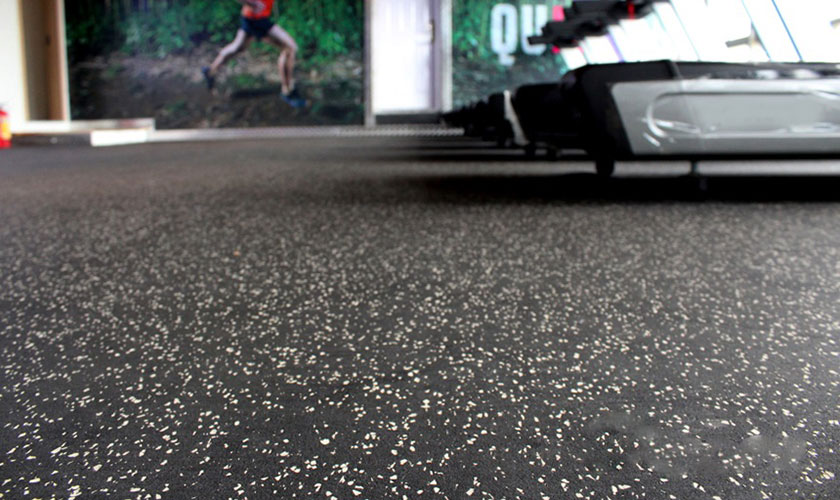When we think of flooring for kitchens and bathrooms, traditional materials like ceramic tiles, vinyl, or even marble usually come to mind. However, a quiet revolution is taking place in modern interior design—rubber flooring is emerging as a top contender for wet zones like kitchens and bathrooms. With its unbeatable blend of comfort, water resistance, and modern aesthetics, rubber flooring is changing how we design and experience these essential spaces.
What is Rubber Flooring?
Rubber flooring is a versatile material made from either natural rubber or recycled rubber tires. Available in tiles, rolls, and interlocking mats, it comes in a wide array of colors, patterns, and thicknesses. Initially popular in commercial and gym settings due to its durability and slip resistance, rubber has gradually entered the residential arena—especially in high-moisture areas.
Why Rubber Flooring is Ideal for Kitchens and Bathrooms
Waterproof and Mold-Resistant
Water is a constant factor in both kitchens and bathrooms, and rubber flooring handles it like a pro. Unlike wood or certain laminates, rubber doesn’t warp or swell when exposed to moisture. Its non-porous surface prevents water from seeping through, which also helps prevent mold and mildew—two common concerns in damp environments.
Slip-Resistant Safety
One of the biggest hazards in wet areas is the risk of slipping. Rubber flooring features a naturally high coefficient of friction, offering excellent slip resistance even when wet. This makes it particularly beneficial for households with children, elderly family members, or anyone with mobility concerns.
Comfort and Cushioning
Rubber provides a soft, cushioned surface that is gentle on feet, joints, and backs. This is particularly valuable in kitchens where standing for long periods is common. Its shock-absorbing properties can also prevent dropped items from breaking—saving dishes and reducing the risk of injury.
Low Maintenance and Easy to Clean
Kitchens and bathrooms require frequent cleaning, and rubber flooring makes this task simple. Its smooth, seamless surface doesn’t trap dirt or grime. A quick mop or damp cloth is usually enough to keep it looking pristine. Additionally, many rubber floors are resistant to stains and chemicals, making them perfect for areas prone to spills.
Modern Design Options
Forget the industrial look of old rubber mats—today’s rubber flooring is stylish and customizable. You’ll find options in matte or gloss finishes, vibrant or neutral color palettes, and even designs that mimic wood, stone, or tile. Whether your style is minimalist, contemporary, or eclectic, rubber flooring can complement your vision.
Design Tips for Rubber Flooring in Wet Areas
If you’re considering rubber flooring in your kitchen or bathroom, here are a few design tips to make the most of its potential:
- Opt for textured finishes for enhanced grip and a modern look.
- Choose darker shades or speckled patterns in kitchens to hide stains and crumbs.
- Use sheet rubber flooring for bathrooms to ensure fewer seams and better water resistance.
- Match flooring color with wall tiles or fixtures for a cohesive, designer-inspired look.
Installation Considerations
Rubber flooring is relatively easy to install, but certain conditions apply, especially in wet zones:
- Subfloor preparation is critical. Make sure the surface is clean, dry, and level.
- Use appropriate adhesives or interlocking mechanisms designed for high-moisture areas.
- In bathrooms, especially near showers or bathtubs, consider sealing seams or edges to prevent any moisture from getting underneath.
Professional installation is recommended for a seamless finish and long-lasting durability.
Environmental Benefits
Many rubber flooring options are made from recycled materials, such as old vehicle tires. By choosing these, homeowners contribute to reducing landfill waste and promoting sustainable building practices. Furthermore, rubber flooring has a long lifespan, meaning fewer replacements and less environmental impact over time.
Cost Considerations
Rubber flooring may come at a slightly higher upfront cost than vinyl or laminate, but its durability, longevity, and low maintenance costs make it a smart investment. Over time, it proves to be a cost-effective and sustainable solution for kitchens and bathrooms.
Final Thoughts
Rubber flooring is not just a practical choice for wet areas—it’s a bold design statement that combines safety, style, and sustainability. As homeowners and designers continue to look for innovative ways to enhance comfort and function, rubber is quickly becoming a favorite for kitchens and bathrooms alike.
Whether you’re remodeling a cozy apartment or designing a luxurious master bath, don’t overlook the waterproof revolution that rubber flooring Dubai brings. With its comfort underfoot, resilient nature, and modern aesthetic, rubber is setting a new standard for smart, stylish interiors.

